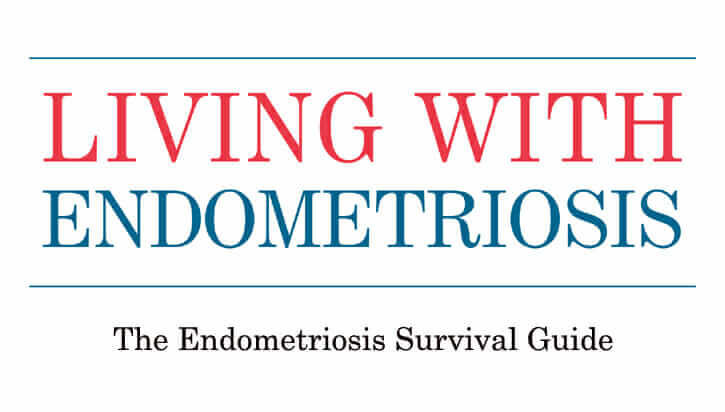March is Endometriosis Awareness Month. Author and endometriosis patient Samantha Bowick has written articles revolving around important questions and information about endometriosis. Her new book Living with Endometriosis: The Complete Guide to Risk Factors, Symptoms, and Treatment Options is out on April 24, 2018.
The Endometriosis Survival Guide
What should you do when you’re diagnosed with endometriosis? The following is your essential Endometriosis Survival Guide—10 key actions everyone should take following their diagnosis.
#1 Understand Your Diagnosis
Take a step back and evaluate where your body is. It is important to understand your body and endometriosis before making any decisions about what treatments to try. Research all available treatment options before deciding on one with your doctor. Do not let your doctor pressure you into any treatments you are not 100% on board with.
#2 Form a Team
You cannot do this alone. From physicians to family, it takes teamwork and specialists to put your endometriosis on the defense. Having support is crucial in fighting this disease. On days when we don’t feel like pushing to find the answers, the support people in our lives are there to keep us going. On that note, it is important that you feel like your doctor is listening to you. If you don’t feel this way, it may be time to find a new doctor. Connecting with other women who also suffer with endometriosis can be extremely helpful because they understand more of what you are going through, can relate to your experiences, and validate how you’re feeling without making you feel judged. This in itself is a form of healing.
#3 Research, Research, Research
Researching endometriosis and all of the treatment options available (both for disease itself and the pain it causes) is crucial in finding the treatment that works best for you. Books, websites, and endometriosis support groups are just a few of the research tools available for women who suffer with endometriosis. Researching allows you to go into your doctor’s appointment knowing beforehand what treatments you are (and more importantly are not) willing to try so that you don’t feel pressured into doing anything that you think is not best for your body.
#4 Know Your Medications and Treatment Options
There are several different types of medications that doctors may prescribe to try to combat symptoms related to endometriosis: pain medications, depression medications, birth controls, Lupron, other forms of estrogen as add-back therapy, nausea medications, and bio-identical hormones. Doctors can also perform different types of laparoscopic surgery to try to remove as much of the disease as possible as well as refer patients to pelvic floor physical therapy. There are also natural ways to potentially decrease symptoms such as diet changes, massages, facials, and herbal treatments.
#5 Keep a List of Your Symptoms
Keeping a list of the symptoms you are/have been experiencing can help you and your doctor determine what is going on and the best course of action. It can also help you remember what to tell your doctor during your appointment as doctor appointments can be overwhelming and cause anxiety. Also, keeping track of your period can be helpful in determining whether it is regular or irregular, as most doctors will usually ask when your last menstrual cycle was.
#6 Know the Risk Factors for Other Diseases
Unfortunately, endometriosis also comes with comorbidities, or other diseases. These include, but are not limited to: adenomyosis, interstitial cystitis, polycystic ovary syndrome, heart disease, osteoporosis, pelvic inflammatory disease, ovarian remnant syndrome, vulvodynia, and vaginismus. Make sure you know about these in case they come up while you’re suffering with endometriosis.
#7 Be Kind to Yourself
When you don’t feel well, remember it is okay to take time for yourself, whether it is to sleep/rest, take a relaxing bath, or turn down plans because you are in pain or suffering other symptoms. Other people may not understand, but that’s okay; they may not know or understand what you are going through, but it is important for you to take care of your body however you think you need to.
#8 Decrease Stress
It is hard to decrease stress, but it is important for women with endometriosis to decrease their stress as much as possible. Exercise if you are up to it; yoga, reading, writing, and coloring are also good things you can do to try to decrease stress and have a release.
#9 Stay Up to Par Mentally
The hardest part of endometriosis is bouncing around from doctor to doctor because they won’t help you or you feel like they aren’t listening to you. This can lead to self-doubt, depression, stress, and anxiety. It is important to stay as positive as possible to try to find answers. It may be hard and feel like a second job, but there is a doctor out there who will listen to you. Keep pushing, as this is an important factor in seeking the health care you need.
#10 Stay Committed
Improving your health and daily life requires an unwavering commitment to the principles and tenets of Living with Endometriosis. The most important factor in putting endometriosis on the defense is to make a commitment to finding what decreases your pain level. It’s important to remember everybody is different and not to give up on finding your answers.
Living with Endometriosis includes expert advice drawn from doctors and researchers tackling this debilitative disease, along with tips for recognizing symptoms and getting the most effective help possible. Pre-order your copy now on Amazon and wherever books are sold. It is available on April 24, 2018.
Samantha Bowick has a Master of Public Health degree from Liberty University. She received a Bachelor of Science degree in Health Care Administration at Columbia Southern University. She is devoted to using her education and experiences to advocate for women who suffer with endometriosis. She currently lives in Aiken, South Carolina.






